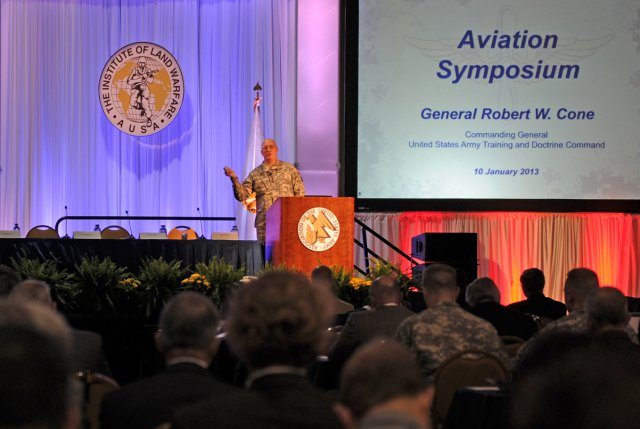With a smaller, leaner force in the future, aviation will play a bigger and more significant role than it has over the last decade, said the Army’s Training and Doctrine commander.
Speaking before members of the Association of the U.S. Army today at its annual aviation symposium and exposition, Gen. Robert W. Cone said the risks associated with a smaller Army can be mitigated by continuing investments in aviation and by finding balance between near-term and long-term readiness of the force.
“TRADOC certainly has a central role in that we design the future operational environment on how we’re going to fight, where we’re going to fight and what the requirements are going to be,” he said. “Then they are translated to strategies, capstone concepts, organizations and then ultimately into specific capabilities that we choose to buy.”
Cone said the near-term versus long-term readiness challenge is that the Army will get to a point where trade-offs will be necessary. The trick, he said, is not to buy too much near-term readiness at the expense of the long-term modernization programs.
He told the audience that on a recent trip to Fort Hood, Texas, he talked with Soldiers from the 3rd Cavalry Regiment and 1st Armored Division and took from them that for the last 10 years “they have been all about readiness and combat capability.
“Probably the greatest accomplishment that the Army has had in the last 10 or 11 years is the development of this generation,” he continued. “If you start telling them they can’t train, they’re going to have a very hard time with that, and it would be my assessment that many of them, certainly the best of them, would start to walk away from the Army as a future.
“They’re not interested in being in a hollow Army, so on the one hand you have to invest in near-term readiness, not only for them, but for a very uncertain world and our requirement to maintain a ready force while not bankrupting the future,” he said.
Cone said the role of Army aviation will continue to grow because the conditions under which enemies, nation-states, proxies and non-state actors, will challenge the United States will remain ambiguous. He said the conflicts will probably be conducted over extended distances and complex terrain.
“Aviation will clearly be in higher demand,” he said. “There will be very difficult terrain, altitude issues, engine power requirements and then speed mobile operations conducted over great distances and over more difficult terrain are certainly going to drive our future and the kinds of platforms that we build.”











